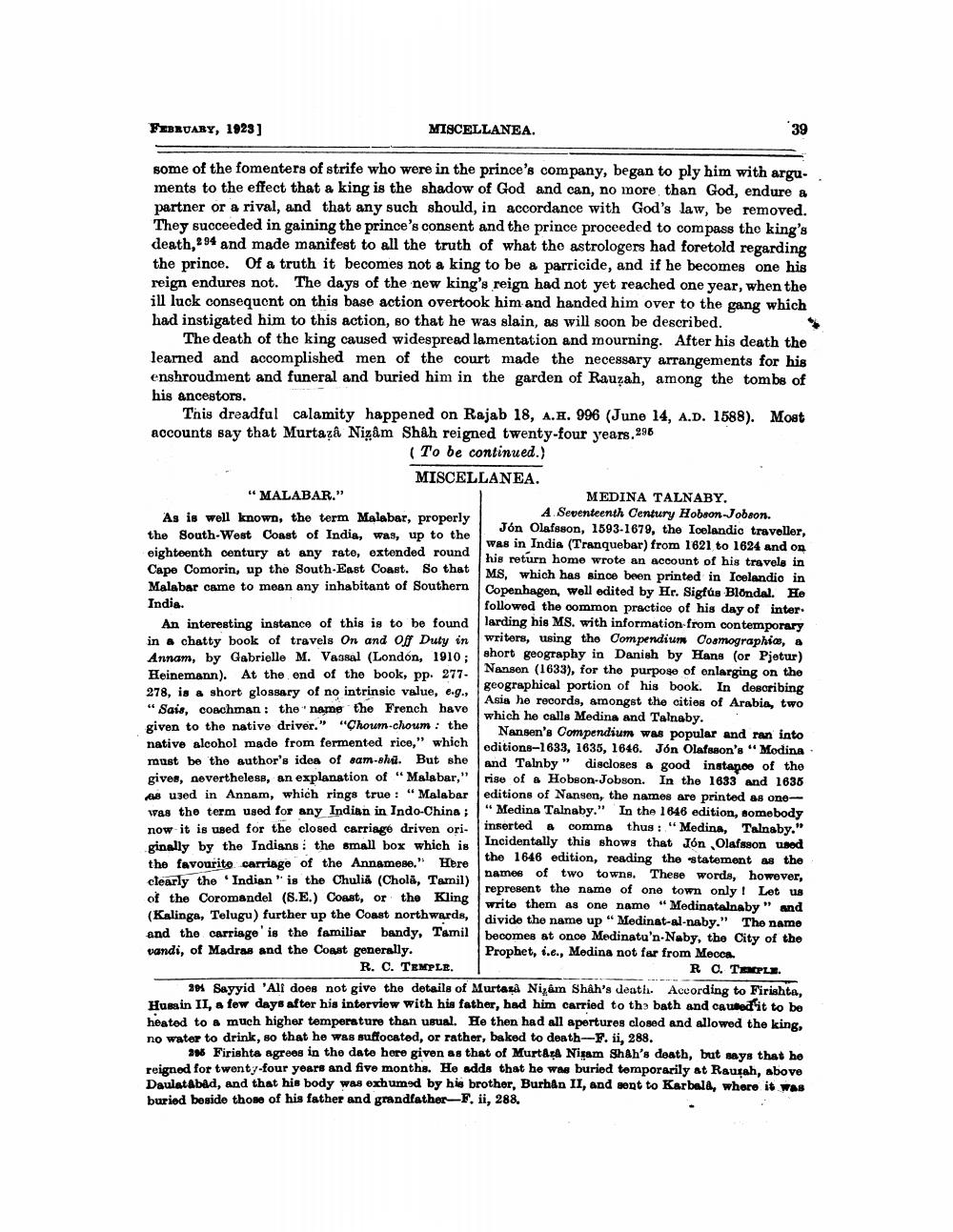________________
FEBRUARY, 1923]
some of the fomenters of strife who were in the prince's company, began to ply him with arguments to the effect that a king is the shadow of God and can, no more than God, endure a partner or a rival, and that any such should, in accordance with God's law, be removed. They succeeded in gaining the prince's consent and the prince proceeded to compass the king's death,294 and made manifest to all the truth of what the astrologers had foretold regarding the prince. Of a truth it becomes not a king to be a parricide, and if he becomes one his reign endures not. The days of the new king's reign had not yet reached one year, when the ill luck consequent on this base action overtook him and handed him over to the gang which had instigated him to this action, so that he was slain, as will soon be described.
The death of the king caused widespread lamentation and mourning. After his death the learned and accomplished men of the court made the necessary arrangements for his enshroudment and funeral and buried him in the garden of Rauzah, among the tombs of his ancestors.
MISCELLANEA.
This dreadful calamity happened on Rajab 18, A.H. 996 (June 14, A.D. 1588). Most accounts say that Murtaza Nizam Shah reigned twenty-four years. 296
(To be continued.)
MISCELLANEA.
"MALABAR."
As is well known, the term Malabar, properly the South-West Coast of India, was, up to the eighteenth century at any rate, extended round Cape Comorin, up the South-East Coast. So that Malabar came to mean any inhabitant of Southern
India.
An interesting instance of this is to be found in a chatty book of travels On and Off Duty in Annam, by Gabrielle M. Vassal (London, 1910; Heinemann). At the end of the book, pp. 277278, is a short glossary of no intrinsic value, e.g., "Sais, coachman: the name the French have given to the native driver." "Choum-choum: the native alcohol made from fermented rice," which must be the author's idea of sam-shi. But she gives, nevertheless, an explanation of "Malabar," as used in Annam, which rings true: "Malabar was the term used for any Indian in Indo-China; now it is used for the closed carriage driven originally by the Indians the small box which is the favourite carriage of the Annamese." Here clearly the Indian" is the Chulia (Chola, Tamil) of the Coromandel (8.E.) Coast, or the Kling (Kalinga, Telugu) further up the Coast northwards, and the carriage' is the familiar bandy, Tamil vandi, of Madras and the Coast generally. R. C. TEMPLE.
"
39
MEDINA TALNABY.
A Seventeenth Century Hobson-Jobson. Jón Olafsson, 1593-1679, the Icelandic traveller, was in India (Tranquebar) from 1621 to 1624 and on his return home wrote an account of his travels in
MS, which has since been printed in Icelandic in Copenhagen, well edited by Hr. Sigfús Blöndal. He followed the common practice of his day of interlarding his MS. with information from contemporary writers, using the Compendium Cosmographics, a short geography in Danish by Hans (or Pjetur) Nansen (1633), for the purpose of enlarging on the
geographical portion of his book. In describing Asia he records, amongst the cities of Arabia, two which he calls Medina and Talnaby.
Nansen's Compendium was popular and ran into editions-1633, 1635, 1646. Jón Olafsson's "Modina and Talnby " discloses a good instance of the rise of a Hobson-Jobson. In the 1633 and 1635 editions of Nansen, the names are printed as one"Medina Talnaby." In the 1646 edition, somebody inserted a comma thus: "Medina, Talnaby." Incidentally this shows that Jón Olafsson used the 1646 edition, reading the statement as the names of two towns. These words, however, represent the name of one town only! Let us write them as one name "Medinatalnaby" and divide the name up " Medinat-al-naby." The name becomes at once Medinatu'n-Naby, the City of the Prophet, i.e., Medina not far from Mecca. R C. TEMPLE.
20 Sayyid 'All does not give the details of Murtaza Nizam Shah's death. According to Firishta, Husain II, a few days after his interview with his father, had him carried to the bath and caused it to be heated to a much higher temperature than usual. He then had all apertures closed and allowed the king, no water to drink, so that he was suffocated, or rather, baked to death-F. ii, 288.
295 Firishta agrees in the date here given as that of Murtaza Nigam Shah's death, but says that he reigned for twenty-four years and five months. He adds that he was buried temporarily at Raurah, above Daulatabad, and that his body was exhumed by his brother, Burhan II, and sent to Karbala, where it was buried beside those of his father and grandfather-F. ii, 288,




